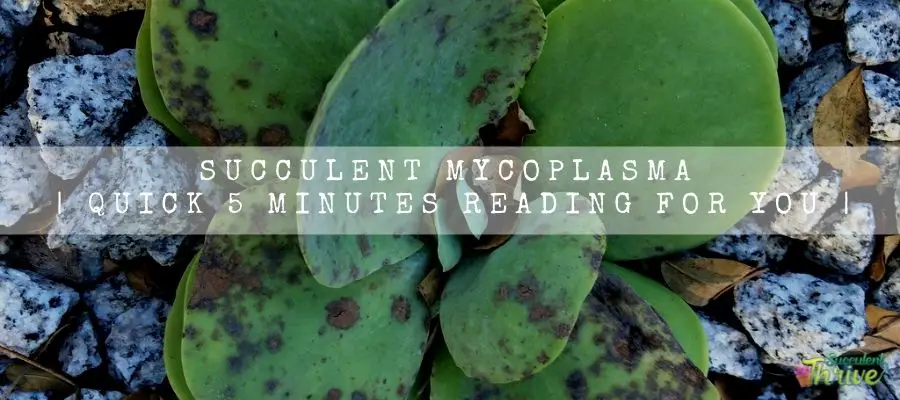Succulent mycoplasma is a bacterial disease. This could be lethal to your plant if untreated. You can find more details about succulent mycoplasma, treatment, and prevention methods in this article.

What is succulent mycoplasma?
Mycoplasma can be found in succulents that have cracked and developed very unpleasant and scabby spots. Generally, what happens is that the bacteria approach the plant through its roots and through its leaves. You could spot this more often when the succulents are at nurseries that have horse manure.
The main cause for mycoplasma is an organism which is called mollicutes. The organism, Mollicutes develop in various forms. It could be attributed to various diseases.
On top of that, they could have different symptoms that vary from disease to disease as well. When they develop in this form, these mycoplasmas cannot develop outside of particular cellular niches within the host. It could sometimes evolve in the cells of the phloem.
Mycoplasma infection in succulents
Normally, these organisms are located in the phloem tissues of the succulent. But sometimes they also reside on the outer surface of the leaves. If I explain this further, the phloem’s job is to transport and transfer food from the leaves to other parts of the plant. If this circulation disturbed by any obstacle, the energy circulation also faces disturbances. In addition to that, it will affect the mineral salts circulation inside the plant. Moreover, it could badly affect the succulent hormones which control the growth and the development of the plant. Hence, all these affect the growth and the development of the plant and lead to deformations.
How to identify succulent mycoplasma
The illness caused by this bacteria is known as Mollicutes mycoplasmosis. They would show diverse symptoms. Following are the symptoms which you could spot once a plant is suffering from mycoplasma,
- Yellowing of the plant
- numerous growth disorders
- discoloration of Colors
- Flower deformations
If we go into details about these symptoms, you could spot this disease once the plant has turned yellow. In addition to that, if you spot any growth disorders like dwarfism, polyphyly, or witches’ brooms, you may decide that those conditions have happened due to the mycoplasma condition of the plant. Further, if the plant has discolored and if it has become variegated, that could have also happened due to mycoplasma.
Moreover, if you spot any deformation of the blooms such as leaf-like parts of flowers, phyllody, they could have occurred due to mycoplasma too. These disorders usually take place when the functioning of the phloem faces interruptions from these organisms.
How succulent mycoplasma spread
Succulent mycoplasma usually spreads through insects. They carry the plant disease mycoplasma from an unhealthy plant to a healthy plant simply by piercing and sucking. You can commonly spot this with homopteran orders like leafhoppers. They suck the sap from a diseased plant which has mycoplasma and transmit it to other plants.
When the leafhoppers transmit this disease, it is persistent. However, it needs some time to develop further to circulate more and to multiply within the vector insect. This literally means, they will keep the plant diseased forever. However, the insects cannot pass the bacteria to offspring.
How to control Succulent mycoplasma
Fungicides
Best is to use a fungicide to treat succulent mycoplasma. You should use Agri-mycin which is a costly horticultural antibiotic. However it could be very useful since the disease damages the plants tissues.
Prevention
As soon you learn there is a mycoplasma disease present in your plant, immediately isolate it from the rest of the plants. You should keep observing your plants on a regular basis. Further you could use chemicals which act against the insects ,specially against the homopterans. Moreover you should remove the affected plants so that it will not spread to other plants.
What is phytoplasma in succulents?
Phytoplasmas is a bacterial disease and could damage plants as well as insects. Insects could transmit this disease by their feeding process, which could inject the pathogen into the phloem tissues of the plants.
When a plant is going through this condition, there could be several kinds of symptoms. All these symptoms affect the plant’s health.
Phytoplasma remains in the phloem cells of a succulent, and usually we cannot spot any symptoms at the beginning of their infection. This is a bacterial type that lacks both cells and nuclei. Hence, they cannot retain any necessary compounds within themselves and should depend on their host instead.
You could call them parasitic because of this. Phytoplasma could damage insect vectors, and they could even do their replication within their host. However, when they are present in a plant, they could do their replication only in the phloem (intracellularly). Experts have discovered that there are 30 identified insect varieties that could spread this disease to other plant varieties. You could consider leafhoppers as the main insect vector of this disease.
There could be several symptoms once it infects a plant. Yellowing is the prominent symptom which you could spot among these plants once they get the phytoplasma condition.
There may be symptoms such as the plant’s growth being disrupted, and it will also give the plant a “witches’ broom” appearance. In addition to that, you could spot unripe fruits and shoots. Moreover, there could be stunned roots and aerial tubers as well. Ultimately, chances are that the plant could perish due to the disease.
What is the white fuzz on my succulents?
This could happen due to a mealybug infection. It is not a fungal infection; these little creatures survive on the plants and develop white fluffy substances on the plant. They could multiply faster, and they could leave a sticky residue which would later become black fungus. However, it could also be due to fungus-caused white mold disease.
Read Next: White Spots On Jade Plant | 5 Minutes Reading For You |
